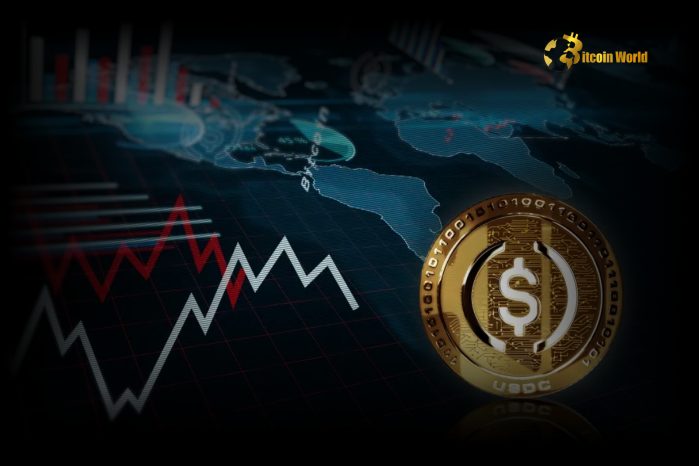Are you closely following the pulse of cryptocurrency regulations in the United States? Many expected Bitcoin to be the central focus of new policies, envisioning its swift ascent to a recognized strategic reserve asset. However, a fascinating twist is unfolding. According to Jeff Park, Head of Alpha Strategies, the real story of the U.S. crypto policy shift is not about Bitcoin at all. Prepare to have your assumptions challenged as we delve into why stablecoins are taking center stage in the evolving regulatory landscape.
Why Stablecoins Are the Epicenter of the US Crypto Policy Shift
Jeff Park’s recent statement on X has sparked significant discussion within the crypto community. He suggests that while much of the crypto world fixates on Bitcoin’s potential as a strategic reserve asset, they’re missing a crucial development: the rapid advancement of stablecoin regulations in the United States. “The story is stablecoins,” Park succinctly stated, highlighting a potentially overlooked area of regulatory action. This insight begs the question: Why are stablecoins, designed for price stability, becoming the focal point of U.S. crypto policy instead of the more volatile Bitcoin?
To understand this shift, let’s break down the key factors:
- Stability in a Volatile Market: Stablecoins, pegged to fiat currencies like the US dollar, offer a semblance of stability within the often turbulent crypto market. This inherent stability makes them attractive for everyday transactions and as a safe haven during market downturns. For regulators, this widespread use and potential integration into the traditional financial system raises immediate concerns about consumer protection and financial stability.
- Payment System Innovation: Stablecoins are emerging as a powerful tool for faster, cheaper, and more efficient payment systems. Their potential to streamline cross-border transactions and disrupt traditional banking infrastructures has caught the attention of policymakers. This potential for innovation, however, also comes with risks related to money laundering and illicit finance, prompting regulatory scrutiny.
- Regulatory Pragmatism: Regulating stablecoins may be perceived as a more pragmatic first step for policymakers. Unlike Bitcoin, which is often viewed as a decentralized and borderless asset, stablecoins, particularly centralized ones, operate within more defined structures. This makes them potentially easier to regulate within existing frameworks, allowing authorities to address immediate risks while they grapple with the broader challenges of crypto regulation.
Bitcoin’s Strategic Reserve Asset Status: A Distant Horizon?
The anticipation of Bitcoin being recognized as a strategic reserve asset has been a driving narrative for many crypto enthusiasts. However, Park’s analysis suggests this might be a longer game than many realize. While the long-term potential of Bitcoin remains undeniable, several factors contribute to the slower pace of its regulatory recognition as a strategic reserve asset:
- Volatility Concerns: Bitcoin’s price volatility is a major hurdle. For governments and institutions considering reserve assets, stability and predictability are paramount. Bitcoin’s dramatic price swings make it a less appealing option compared to more stable assets.
- Decentralization and Control: Bitcoin’s decentralized nature, while a core tenet of its appeal, also presents regulatory challenges. Governments traditionally prefer assets they can control or at least significantly influence. Bitcoin’s decentralized architecture makes it harder to fit into traditional regulatory molds.
- Geopolitical Implications: The global and borderless nature of Bitcoin raises complex geopolitical considerations. Nations are still navigating how to incorporate such a decentralized asset into their existing financial and economic strategies, which requires international cooperation and consensus-building – a process that inherently takes time.
Decoding the Rapid Pace of Stablecoin Regulation
So, what exactly does this rapid advancement in stablecoin regulation look like? While specific regulations are still evolving, we can observe some key trends and areas of focus:
| Regulatory Focus Area | Rationale | Potential Impact |
|---|---|---|
| Consumer Protection | Ensuring users are protected from risks associated with stablecoin usage, such as loss of value or fraudulent schemes. | Stricter disclosure requirements, reserve requirements, and redemption policies for stablecoin issuers. |
| Financial Stability | Mitigating systemic risks that stablecoins could pose to the broader financial system, especially if they achieve widespread adoption. | Capital requirements for issuers, enhanced oversight of stablecoin reserves, and potential limitations on stablecoin issuance. |
| Anti-Money Laundering (AML) & Combating Financing of Terrorism (CFT) | Preventing the use of stablecoins for illicit activities. | Enhanced KYC (Know Your Customer) and transaction monitoring requirements for stablecoin platforms and users. |
| Interoperability & Standards | Promoting seamless integration of stablecoins within the existing financial infrastructure and fostering global regulatory harmonization. | Development of common standards for stablecoin issuance and operation, and collaboration between international regulatory bodies. |
Navigating the Evolving Landscape of Digital Assets
For businesses and individuals operating within the digital assets space, understanding this policy shift is crucial. It’s no longer sufficient to solely focus on Bitcoin’s price action or technological advancements. Paying close attention to stablecoin regulations and their implications is becoming increasingly important. Here are some actionable insights:
- Stay Informed on Regulatory Developments: Actively monitor announcements and policy proposals from regulatory bodies like the SEC, Treasury Department, and Federal Reserve concerning stablecoins.
- Assess Stablecoin Exposure: Evaluate your business’s or investment portfolio’s exposure to stablecoins and understand the potential impact of upcoming regulations.
- Engage in Industry Discussions: Participate in industry forums and discussions surrounding stablecoin regulation to contribute to the shaping of responsible and effective policies.
- Prepare for Compliance: Proactively prepare for stricter compliance requirements related to stablecoins, particularly in areas like KYC/AML and reporting.
The Unfolding Crypto Narrative: Beyond Bitcoin’s Shadow
The U.S. crypto policy narrative is indeed shifting, and as Jeff Park points out, it’s a shift many are yet to fully grasp. While Bitcoin remains a cornerstone of the crypto ecosystem and a subject of ongoing debate, the immediate regulatory focus is undeniably on stablecoins. This doesn’t diminish Bitcoin’s significance but rather highlights the pragmatic and phased approach regulators are taking. By addressing stablecoins first, policymakers are tackling immediate concerns related to consumer protection, financial stability, and payment system innovation, while laying the groundwork for a more comprehensive approach to crypto regulation in the future. The spotlight is currently on stablecoins, signaling a crucial and perhaps surprising chapter in the ongoing crypto evolution.
To learn more about the latest crypto regulation trends, explore our article on key developments shaping digital assets policy and market dynamics.
News – BitcoinWorld – Read More









